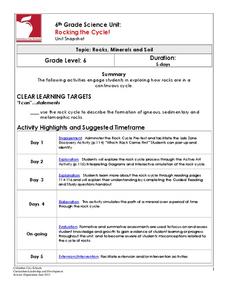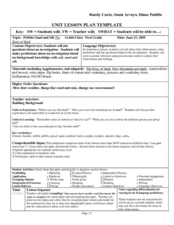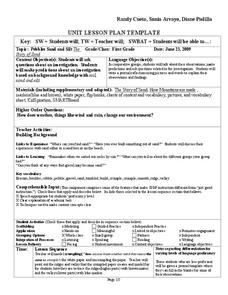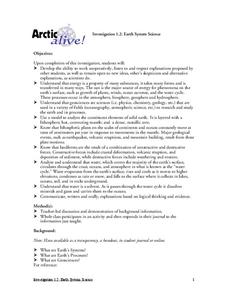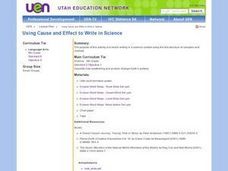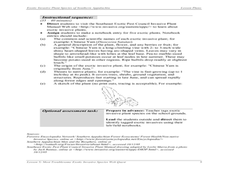Curated OER
TRB 5:2 - Activity 3: Earthquakes
Students watch a classroom demonstration, and experiment to discover the five ways that Earth's crust shifts along a fault.
Columbus City Schools
Rocking the Cycle!
Time to rock out! Discover the "life" cycle of the average rock using an illustrative stations lab and stimulating pairs game. Roll the dice to determine your fate: will it be melting in magma or chilling out to form igneous rock? The...
Curated OER
Hos Do the Jaguar and Howler Monkeys in Belize Depend on Us?
First graders access the internet and use the sites provided to research Belize, and in particular, the Howler Monkey and Jaguar. Students participate in activities/centers utilizing the information they discovered.
Curated OER
Constructive and Destructive forces
Learners explore constructive and destructive forces. In this constructive and destructive forces instructional activity, students complete a WebQuest. Learners explore the different types of forces and their effect on the surrounding...
Curated OER
Water: Naturally Cleaned
Middle schoolers use stream trays covered in different types of rocks or soil to investigate infiltrates and runoff. For this water pollution lesson, students work in groups with stream trays that have different substrates. They write a...
Curated OER
Mars Geologic Mapping
Young scholars identify and interpret photographic details of a Martian surface image, design, and create a simple features map. They identify and interpret the geologic history of a part of Mars' surface and then, analyze and discuss...
Curated OER
Using the Internet
In this using the internet worksheet, students search several websites to review information about the heart, human senses, the solar system, and planets. Students also read information about the rock cycle and answer provided questions.
Curated OER
Cruising the Mantle
Students explore the plate boundaries of the earth. Through the use of video, internet and hands-on activities, students examine the types of plate boundaries. They create a model to illustrate the movement and interaction of the...
Curated OER
Impact Craters: Holes in the Ground!
Students simulate crater formation through a lab activity. In this space science lesson, students calculate how much energy is transferred during meteorite impact. They identify different factors affecting the size and depth of craters...
Curated OER
Relative Age Dating
Modeling dough and paper cutouts in science class? Learn about how relative age dating concepts, like the Law of Superposition and cross-cutting relationships, can be used to describe the formation of sedimentary layers.
Curated OER
You're as Cold as Ice!
Students study the movement of glaciers and how they have affected the Earth. In this geology lesson plan students simulate the effects glaciers have on landscape and watch video segments.
Curated OER
Physical Science Fun
Fifth graders explain how the land changes by developing some "land dances." Working in cooperative groups, each group develops a movement sequence that depicts the vocabulary word they are given. They teach dance to other classmates.
Curated OER
World's Most Dynamic Force
Pupils explore the Earth's forces. They review an assessment task and its accompanying rubric. They classify ten items as long-term or short-term interactions of the Earth's components and rank the destructive impact of the forces. ...
Curated OER
Name that Wind
Students study wind and the direction terms related to wind. For this meteorology lesson, students learn about the wind directions by completing a wind direction activity where kids locate cones marked with the specific wind...
Curated OER
Impact Craters
Students investigate the factors affecting the size of a crater. In this space science lesson, students collect data from the activity and graph them. They explain how velocity of impact relate to crater size.
Curated OER
Space Science: A Scoop of Moon Dirt
Students discover soil characteristics and how it is formed on Earth and the Moon by examining local samples to a lunar simulant. They replicate the effects of wind erosion by scraping dry bread with sandpaper. Students use rocks and...
Curated OER
Pebbles Sand and Silt
First graders investigate soil, sand and silt. In this environment lesson, 1st graders discuss how changes occur in the environment and the effects of weather. Students perform their own investigation and record their predictions,...
Curated OER
Unit Lesson Plan Template
First graders listen to the book The Story of Sand and make predictions about an investigation based on soil, sand, and silt. For this sand lesson, 1st graders work in groups to discuss their observations about sand and answer higher...
Curated OER
Pass the Plate
Young scholars define constructive forces. They describe how landforms are created as a result of constructive forces. Students recognize active volcano areas in the United States. They demonstrate an understanding of Panagea.
Curated OER
Tracking Current "Earth" Events
Eighth graders utilize Internet research skills, and practice their communication skills by presenting their research to the clas. They actively consider the types of hazards for humans associated with Natural Disaters and ways that...
Curated OER
Earth System Science
Students explore the Earth and its ability to support life. They discuss the geosphere and the water cycle and complete the Water Wonders activity. After completing the activity, they respond in their journals and reflect upon the...
Curated OER
Using Cause and Effect to Write in Science
Fifth graders brainstorm processes or forces that cause Earth's surface to be changed.
Curated OER
Franklin Mountains
Middle schoolers review the steps of the rock cycle. In groups, they identify the natural forces that cause weathering and erosion. They describe how sedimentary, metamorphic and igneous rocks might be formed in nature to end the lesson...
Curated OER
Most Troublesome Exotic Invasive Plant Species Web Quest
Students participate in a Web Quest activity in which they identify common exotic invasive plant species of the Southern Appalachian Region. After identifying the top 10 exotic invasive species, they choose one to research in depth.



